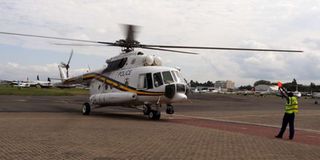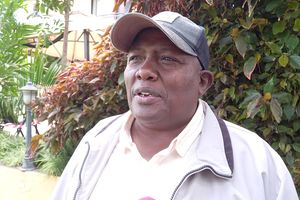Premium
After meat, Uhuru set to hand over choppers to military

A police helicopter at Wilson Airport.
What you need to know:
- On Tuesday, Air Force Commander Major General Francis Ogolla and Police IG Hillary Mutyambai visited the National Police Airwing at Wilson Airport.
- Several officials who spoke to the Nation cited their confusion over the matter.
- Normally, the Kenya Army has its own fleet of helicopters run by the Joint Helicopter Command.
- Previous efforts to bring together Kenya Army and Kenya Air Force helicopters have failed.
The expected handover of government owned helicopters to the Kenya Air Force has created uncertainty with confusion over whether the various affected agencies will continue to operate them semi-autonomously or if they will be under direct command of the military.
Some of the government bodies which will be affected by the changes have also questioned the transparency and effectiveness of the military which has lost as many as three choppers this year alone.
Further, they have cited the diverse roles in their operations and how they will blend within a central command.
Weeks after handing over the government’s meat production by the Kenya Meat Commission (KMC) to the Kenya Defence Forces (KDF), President Uhuru Kenyatta is expected to sign an Executive Order that will see KDF run all State-owned helicopters.
Orientation
After weeks of rumours in government circles about the plot, on Tuesday, Air Force Commander Major General Francis Ogolla and Inspector-General of Police Hillary Mutyambai visited the National Police Airwing based at Wilson Airport to carry out an “orientation” on the expected changes.
The visit came days after officers from the Kenya Air Force visited the National Police Airwing and other State corporations and bodies which operate helicopters to carry out an assessment of their air assets.
Some of the bodies that the Air Force personnel have visited include the Kenya Wildlife Service (KWS), Kenya Forest Service (KFS), KenGen, Kenya Power and Ketraco (Kenya Electricity Transmission Company).
Several officials who spoke to the Nation cited their confusion over the matter if the President goes ahead to implement the expected changes.
Normally, the Kenya Army has its own fleet of helicopters run by the Joint Helicopter Command (JHC), the unit formed to replace the disbanded 50ACB (50-Air Calvary Battalion).
Joint command
The Joint Helicopter Command, based in Embakasi Garrison, is under the command of Colonel Duncan Kabonyi and operates attack and armed helicopters.
Some of the attack helicopters run by the Joint Helicopter Command include MD500, MD530 cayuse warrior and the stinging Z9.
The attack helicopters are deployed ahead of or alongside infantry troops to destroy enemy defences and deal with armoured tanks.
The Kenya Air Force, which is under the command of Major General Francis Ogolla, runs utility helicopters.
But recently, the Kenya Air Force has also acquired attack helicopters, among them two AH-1F Cobra choppers from the Jordanian military and the Mi-28 Havoc attack helicopter.
Last year, combat Fennec helicopters initially intended to be delivered to the Kenya Army were instead taken to the Kenya Air Force, much to the chagrin of Kenya Army personnel.
Of importance will be whether the helicopters being operated by the army will also be handed over to the Kenya Air Force.
Notably, previous efforts to bring together Kenya Army and Kenya Air Force helicopters have failed.
Helicopter accidents
In the recent past, KDF has lost helicopters in accidents in Wajir, Machakos and Kulbiyow in Somalia, totalling to losses of over a billion shillings.
In the July accident, an investigation report cites pilot error as the cause of the crash which killed Major Robert Ngombwa and Major Jacob Agunda.
The Kenya Police Airwing, which also has its own share of air crashes, has seven operational choppers and two fixed wing aircraft. It has 21 pilots and 39 trainee pilots.
The KWS Airwing has over 40 pilots operating its fleet of 12 light aircraft and three larger aircraft, including a Bell 206 helicopter, C-182, C-180, C-206, C-208, Bell 407 and 4 HUSKYS.
Other than operating a chopper, the Kenya Forest Service also owns a fixed wing Cessna Caravan 14-seater.





